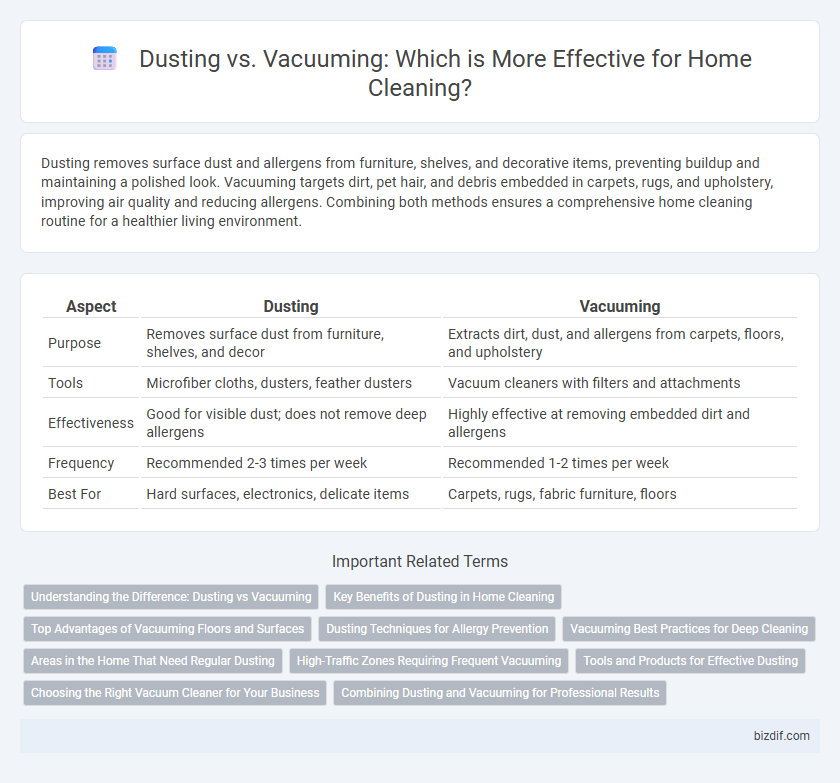Dusting removes surface dust and allergens from furniture, shelves, and decorative items, preventing buildup and maintaining a polished look. Vacuuming targets dirt, pet hair, and debris embedded in carpets, rugs, and upholstery, improving air quality and reducing allergens. Combining both methods ensures a comprehensive home cleaning routine for a healthier living environment.
Table of Comparison
| Aspect | Dusting | Vacuuming |
|---|---|---|
| Purpose | Removes surface dust from furniture, shelves, and decor | Extracts dirt, dust, and allergens from carpets, floors, and upholstery |
| Tools | Microfiber cloths, dusters, feather dusters | Vacuum cleaners with filters and attachments |
| Effectiveness | Good for visible dust; does not remove deep allergens | Highly effective at removing embedded dirt and allergens |
| Frequency | Recommended 2-3 times per week | Recommended 1-2 times per week |
| Best For | Hard surfaces, electronics, delicate items | Carpets, rugs, fabric furniture, floors |
Understanding the Difference: Dusting vs Vacuuming
Dusting removes surface dust and allergens from furniture, shelves, and decor using cloths or microfiber tools, targeting areas where dust settles visibly. Vacuuming, by contrast, uses suction to eliminate dust, dirt, and debris embedded in carpets, rugs, upholstery, and hard floors, reaching deeper layers. Understanding the difference enhances home cleaning efficiency by addressing both airborne particles and hidden contaminants for healthier indoor air quality.
Key Benefits of Dusting in Home Cleaning
Dusting effectively removes allergens, dust mites, and pet dander from surfaces, improving indoor air quality and reducing allergy symptoms. It reaches areas that vacuums may miss, such as shelves, blinds, and delicate furniture, preserving household items and preventing damage. Regular dusting also enhances the appearance of a home by keeping surfaces visibly clean and free of dust buildup.
Top Advantages of Vacuuming Floors and Surfaces
Vacuuming floors and surfaces effectively removes dust, allergens, and debris from carpets, rugs, and hard floors, improving indoor air quality and reducing allergy symptoms. Its powerful suction reaches deep into fibers and crevices, capturing fine particles that dusting alone cannot eliminate. Vacuuming also extends the lifespan of carpets and upholstery by preventing dirt buildup and wear.
Dusting Techniques for Allergy Prevention
Effective dusting techniques for allergy prevention involve using microfiber cloths or electrostatic dusters that trap dust particles instead of spreading them into the air. Regularly dusting surfaces, including hard-to-reach areas like ceiling fans and baseboards, reduces allergen buildup and improves indoor air quality. Combining dusting with HEPA-filter vacuuming on carpets and upholstery maximizes allergen removal and supports a healthier home environment.
Vacuuming Best Practices for Deep Cleaning
Vacuuming effectively captures dust, allergens, and fine debris from carpets, upholstery, and hard floors using high-powered suction and rotating brushes, enhancing indoor air quality. Regularly emptying the vacuum bag or canister and cleaning filters maintain optimal performance and extend the machine's lifespan. For deep cleaning, vacuum in multiple directions and use attachments for edges and hard-to-reach areas to ensure thorough dust and particle removal.
Areas in the Home That Need Regular Dusting
Areas in the home that need regular dusting include surfaces like shelves, baseboards, window sills, and ceiling fans where dust accumulates quickly. While vacuuming effectively removes dust from carpets and upholstered furniture, dusting is essential for hard-to-reach spots and delicate items such as electronics, picture frames, and blinds. Maintaining a consistent dusting routine helps improve indoor air quality by preventing dust buildup on these critical surfaces.
High-Traffic Zones Requiring Frequent Vacuuming
High-traffic zones such as entryways, living rooms, and hallways accumulate dust, dirt, and allergens more rapidly, necessitating frequent vacuuming to maintain indoor air quality and surface cleanliness. While dusting removes surface dust on furniture and decor, vacuuming effectively extracts embedded debris and pet hair from carpets and rugs in these heavily used areas. Regular vacuuming in high-traffic zones reduces the buildup of particulate matter, minimizing respiratory irritants and prolonging the life of flooring materials.
Tools and Products for Effective Dusting
Effective dusting requires microfiber cloths, electrostatic dusters, and furniture polish sprays to capture and trap dust particles without spreading them into the air. Vacuuming tools for dust removal include vacuums with HEPA filters, motorized brush attachments, and crevice tools designed to reach tight spaces and eliminate allergens thoroughly. Using the correct combination of these specialized dusting and vacuuming products significantly enhances home cleanliness and air quality.
Choosing the Right Vacuum Cleaner for Your Business
Selecting the right vacuum cleaner for your business hinges on the specific cleaning needs, such as carpeted areas or hard floors, and the frequency of use. Commercial-grade vacuums with HEPA filters enhance dust removal and improve indoor air quality, essential for maintaining a healthy environment. Opt for models with strong suction power, durable construction, and customizable attachments to efficiently handle diverse dusting and vacuuming tasks in professional settings.
Combining Dusting and Vacuuming for Professional Results
Combining dusting and vacuuming enhances home cleaning by targeting both surface dust and embedded debris in carpets and upholstery. Efficient dusting removes fine particles from furniture, shelves, and electronics, while vacuuming captures allergens and dirt from floors and hard-to-reach areas. Using both techniques together ensures a thorough, professional-level clean, improving indoor air quality and prolonging the life of furnishings.
Dusting vs Vacuuming Infographic

 bizdif.com
bizdif.com